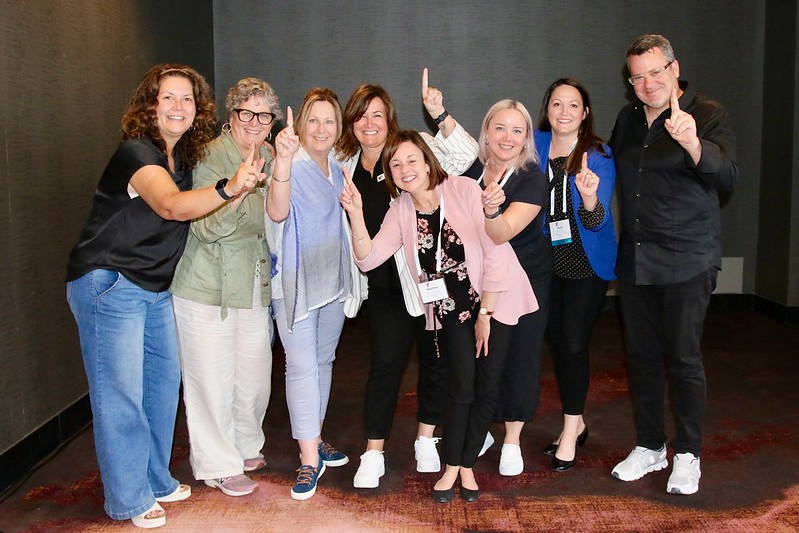Wish You Were Here: Insights from Convene Canada 2024
Jenny Love
Published: 06/03/2024

We just got back from the 2024 AHP Convene Canada conference, which was packed with fantastic sessions. Here are just a few highlights from among the many insights that were shared.
Create an Outsized Digital Footprint on a Tiny Budget
When your shop has a small staff and an even smaller budget, establishing and maintaining the robust digital presence today’s donors demand is challenging. Shauna Nyrose, vice president of brand and communications, and Brad Doyle, digital communications manager, from KGH Foundation reassure you that it can be done. Many popular digital technology platforms, including Google Ads, Canva, Adobe Creative Cloud, Hootsuite, Constant Contact, and Trello, offer free or discounted offers for nonprofit organizations. (Hint: Even if a company doesn’t advertise such a discount, it doesn’t hurt to ask.) Shauna and Brad also recommend embracing automation and AI to streamline operations and increase the leverage of a small team. Email automation can be used for tasks such as gift anniversaries and signup dates. Use Zapier to simplify project management and to automate social listening. And generative AI tools like ChatGPT have practical applications well beyond copywriting: including data visualization, analysis, research, and brainstorming. Don’t be afraid to experiment.
Understand Women’s Motivations for Giving to Connect with Them Effectively
Women’s philanthropic contributions have increased dramatically, say Christy Miller of Global Philanthropic Canada and Jennifer Malloy of the Royal University Hospital Foundation, with donations from Canadian women close to tripling between 2011 and 2022. This growing financial influence, coupled with their preference for hands-on involvement and community-focused giving, underscores the importance of targeted philanthropy programs that engage and empower women donors. Women's involvement in philanthropy differs significantly from men's in several key ways. Women are more likely to volunteer, contribute more hours, and seek direct involvement with the organizations they support. Their giving is motivated by a desire for systemic change and community impact rather than short-term fixes. Women also tend to collaborate more, often participating in giving circles and collective initiatives. Understanding women’s motivations is critical to better connecting with this key group of donors.
Be Proactive with Your Hospital Partners about Funding Priorities
No one likes being handed a list of equipment to raise money for, especially when it is filled with items like bed pans and lawn tractors. Jenny Mitchell, CFRE, CEC, DMA, founder and chief executive officer, and Sherry Schaefer, MHS of Chavender, encourage you to get yourself included in the hospital’s process for determining funding priorities to avoid this fate. When Sherry got involved in this manner, she was able to guide the conversation and prioritize needs that she could actually raise money for. “When we were included in the conversation, we were able to maximize the support we could give to the system,” she said. Jenny encourages you to use your time in these meetings to reframe the conversation around the “whys” behind the items on the priority list, using questions like, “If money were no object, how would your program or department look different?” and, “What do you love about your job?” to get at people’s passions, and increase the likelihood of uncovering potential fundraising opportunities.
Master the Art of the Pitch
Hugh Lawson, Principal at the Hugh & Ilene Lawson Charitable Organization, recommended borrowing ideas from The Challenger Sale, by Matthew Dixon and Brent Adamson, a methodology created to teach sales professionals how to drive performance by challenging customers' thinking and providing unique insights that address their key problems. By mastering the five pillars of commercial teaching—The Warmer, The Reframe, Rational Drowning, A New Way, and Emotional Impact—you can craft pitches that resonate deeply. When you engage your audience with clear communication, build trust with compelling narratives, and use visuals to reinforce your message, you'll set yourself up to be more effective and impactful.
Your Organization Needs a Succession Plan
Even though leadership transition is inevitable, over 75% either don't have a succession plan or don't know if they have one. If your organization is one of them, Christoph Clodius, vice president of search and leadership development at The Discovery Group, and Veronica Carroll, MBA CFRE, chief executive officer of the Children's Health Foundation of Vancouver Island, have some advice to get started. They emphasized the importance of viewing succession planning as a dynamic, ongoing process rather than a static document. The first step in creating a succession plan is to determine who owns the plan and who is responsible for its development. While the board typically owns the succession plan for the CEO, it is valuable for any critical role within the organization. Instead of viewing a succession plan as a guaranteed internal promotion, the plan should involve developing leadership skills within the team and creating a leaderful culture. Succession planning should also embed diversity, equity, and inclusion (DEI) principles to develop a more inclusive leadership pipeline, since 88% of diversity and inclusion leaders identify promotions and succession as processes most susceptible to bias.
Become Your Donors’ Favo(u)rite Charity to Drive Legacy Gifts
Being a donor's favorite charity significantly increases the likelihood of receiving legacy gifts due to the deeper emotional connection, trust, and commitment from the donor, according to Kimberley Blease, executive vice president at Blakely Fundraising. This status is achieved through exceptional donor experiences that align with the donor's values and demonstrate the organization's impact and reliability. Kimberly recommends creating a value proposition specifically for legacy giving to show prospective donors the problem they are solving through a legacy gift, and how you are helping to solve it. “You need to ask, ‘why legacy?’ for your organization,” Kimberly says. “When we ask, ‘please give today’ or ‘please give monthly,’ that's a different ask than, 'please put us in your will.'”